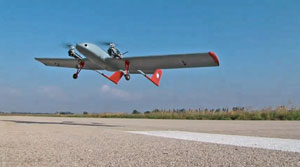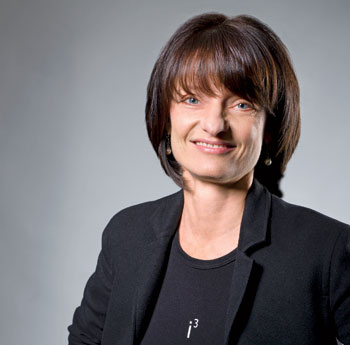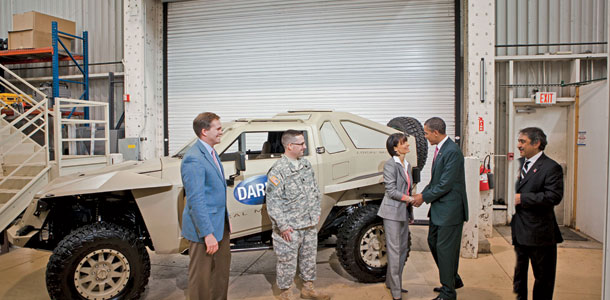DARPA director Regina Dugan is bringing speed and creative thinking to the Pentagon.
 Dugan, shown here with the Nano Hummingbird, a miniature flying robot with a camera that can transmit live video. | Photo by Douglas Sonders
Dugan, shown here with the Nano Hummingbird, a miniature flying robot with a camera that can transmit live video. | Photo by Douglas Sonders
 In August, a hypersonic military plane flying at 20 times the speed of sound vanished into the Pacific Ocean, nine minutes after launching from Vandenberg Air Force Base, in Lompoc, California. The unmanned flight was an experiment conducted by DARPA, the Defense Advanced Research Projects Agency, a Defense Department division responsible for the development of new military technology. The plane cost millions to build, and this was the second time in two years this kind of craft had been lost. Yet Regina Dugan, DARPA's cool-blooded director, was not overly vexed. "You can't lose your nerve for the big failure because you need exactly the same nerve for the big success," Dugan had earlier told Fast Company during a 90-minute interview at DARPA headquarters, in Arlington, Virginia.
In August, a hypersonic military plane flying at 20 times the speed of sound vanished into the Pacific Ocean, nine minutes after launching from Vandenberg Air Force Base, in Lompoc, California. The unmanned flight was an experiment conducted by DARPA, the Defense Advanced Research Projects Agency, a Defense Department division responsible for the development of new military technology. The plane cost millions to build, and this was the second time in two years this kind of craft had been lost. Yet Regina Dugan, DARPA's cool-blooded director, was not overly vexed. "You can't lose your nerve for the big failure because you need exactly the same nerve for the big success," Dugan had earlier told Fast Company during a 90-minute interview at DARPA headquarters, in Arlington, Virginia.
Blistering speed and big splashes--in the Pacific and at the Pentagon--have characterized the 48-year-old Dugan's tenure as DARPA director. The first woman to hold the role, Dugan has invigorated the agency (whose inventions led to computer networking and GPS, among other technologies that have had transformative impact on civilian life) with initiatives that may fundamentally change the way the military innovates. She has centered DARPA's focus on the intersection of basic and applied research. She is so focused on speeding up the time from blue-sky idea to delivery of product that she has embraced crowdsourcing for both idea creation and manufacturing. Turning to the masses may seem antithetical to military secrecy, but Dugan's unorthodox approach fits with another goal of hers: welcoming a wider array of smaller contractors to bid for DARPA projects (including AeroVironment, which fabricated the Nano Hummingbirds on the previous page). In the mini-society known as the military industrial complex, none of this is simple or uncontroversial. Earlier this year, it was revealed that DARPA had awarded a private defense firm that Dugan founded with her father and uncle $6 million in contracts over the past several years, including $1.75 million since she became agency director. Her former firm, in which she still holds a hefty stake, also owes her $250,000 for a loan she made. Dugan says she properly recused herself from all related decisions ("There's nothing more important to me personally than ethics," she told Fast Company), but critics worry that her influence played a role; the Department of Defense's Inspector General is investigating.
While her past is attracting attention, Dugan is firmly focused on the future. She shuns the spotlight, so much so that she requested through her deputies that Fast Company not run this story as an interview, fearing that an undue focus on her would diminish the accomplishments of her program managers (in whose ranks she dwelled several years ago). It's clear that Dugan's ambition for DARPA is limitless; her vision audacious. But the question remains: Will she succeed, or will her agenda--like that hypersonic vehicle--crash and burn like a short-lived experiment?
FC: So, Dr. Dugan, when did you first realize you were good at math and science? Back in advanced calculus class in high school. Whenever I would speak, the other students would make computer sounds in the back of the room. Bleeping and fussing, whirring, all kinds of sounds. At moments like that I thought, Hmm, there's something different here.
Turning to the crowdThree programs that are accelerating under Dugan's watch
//Cyber Fast Track The government has had trouble keeping up with threats to America's computer networks, which are constantly evolving. The solution: Deploy unorthodox strategies divined by a motley crew of unconventional players, including hackers, hobbyists, and independent researchers, while cutting bureaucratic red tape. Developers retain intellectual-property rights.

//UAVForge DARPA is crowdsourcing the design and construction of a portable, backpack-size unmanned aerial vehicle to fly into "critical environments" and conduct surveillance. Teams of inventors post their plans to a DARPA website where the crowd can weigh in with suggestions. Top teams are invited to demo their tech at a "fly-off" where the winning group will receive $100,000. A DARPA subcontractor will build prototypes that the inventors can demonstrate in a war-fighter exercise.
//System F6 This crowdsourced approach to space-worthy hardware and software started three years ago with the goal of restructuring the way satellites, which run a minimum of $100 million to launch, are built. Instead of constructing a satellite as one big project, the idea is to break it into constituent pieces that can be built by different vendors of all sizes and specialties. Then each piece could be launched separately until all the parts join up in a virtual satellite formation in orbit, flying for the duration of the mission, and talking to each other wirelessly.
Did you play sports? I did. My father had three girls. We were very close in age, and he coached us all in softball. He always had two of us who were split in the age groups, so I got him every other year as a coach. I played third base--and I was a catcher for a while, which I loved. You're in every play, and you get really dirty.
What attracted you to engineering? For a while in high school, I thought I would be an architect because I liked the combination of technical discipline with the creative side of architecture. I was curious about everything, pulled in all directions by different subjects. But then I figured out that engineering could be every bit as creative as architecture.
You went to Virginia Tech and got your master's there. Then what? I went to NASA. I actually got my first patent at NASA, for a system designed to refuel satellites in orbit.
Did any of that technology work its way into launches? We did quite a bit of testing, and it might have been successful had time not passed. It just never came about because the need wasn't there. Refreshing the electronics became more important than refueling.
Was there a lesson there? Perhaps in the amount of time it takes for innovations to work their way into the product side? I had left NASA by the time they made these decisions, so I don't know the specifics. But I do think that speed is part of the innovation process. If ideas aren't built on with a sense of urgency, time can pass you by.
This isn't just a problem for the government. It's a problem for everyone: The difficulty of making new ideas broadly available. And yet some ideas move quickly. Look at the progression of radio, television, the Internet, the iPod, Facebook. The acceleration in getting to millions of users has gone from 38 years to less than 4. That's something that we've paid a lot of attention to: How do we increase the speed at DARPA?
That seems a key part of your mission since you got here--that it's not enough to be doing cutting-edge research. When deputy director Kaigham Gabriel and I got here, we understood that DARPA is one of the gems of the nation. We had been asked to take good care of her. For me, part of that meant really understanding why DARPA has this half-century of success in innovation. And the first element in DARPA's success is the power that lies at the intersection of basic science and application, in the so-called Pasteur's Quadrant. Do you know Stokes's theory of innovation?
Absolutely not. Donald E. Stokes wrote a theory of innovation in the late 1990s. Till then, most people thought of innovation as a linear process. You do basic science; then you do more advanced science; then you do the application work; then you commercialize it. What Stokes suggested is that it doesn't happen that way at all. He preferred to think of it in a quadrant fashion, defining one row as very deep science and the other as light science; the two columns were a low-application drive and a high-application drive. Pasteur's Quadrant happens at the deep-science-, high-application-drive quadrant. That's DARPA's absolute power lane. It's called Pasteur's Quadrant because serious concerns about food safety drove his research.
 Photo by Douglas Sonders
Photo by Douglas Sonders
A very recent example of how it works for us is the blast-gauge work that we do. Here's a big problem: TBI, traumatic brain injuries. So the way we approach it at DARPA is to say, "Okay, let's understand the basic science, the phenomenology. How is it that an encounter with a blast injures the brain? What levels of blasts cause what levels of injury? Is it the overpressure? Is it the acceleration? What is it?" A medical person from DARPA researched this and discovered it was the overpressure. And the DARPA physicist says, "We know how to measure that." Together, they devise this little blast gauge that's the size of a couple stacks of quarters [the gauge helps doctors measure a soldier's blast-exposure level, enabling better assessment of injuries]. They develop it in one year, going through four iterations of the electronics. That's fast.
All of this leads back to the idea of shipping products. The defense world is like a mini-society. It has to deploy to anyplace in the world on a moment's notice, and it has to work in a life-or-death situation. That kind of focus, that kind of drive to ship an application, really does inspire greater genius. And the constancy of funding that comes with that--in good times or bad, whether this party or that party is in power--also helps inspire innovation.
You've introduced a number of projects that seem to be designed to speed up and open up innovation at DARPA. To increase the speed of innovation here, we want to increase the number of people who can contribute ideas to the creative process. We're trying to get that going with things like the Adaptive Vehicle Make program, the Accelerated Manufacture of Pharmaceuticals, and a whole host of space-program projects. Then there's also how we engage with the scientific and business communities. We structure programs so that we can have diversity of involvement from universities to small businesses to large businesses to garage inventors. You're looking for the maximum number of folks who can contribute ideas to the process. So we're trying to catalyze and grab the best ideas no matter where they come from, leveraging the most modern concepts of crowdsourcing and harnessing creative power. Look at the semiconductor industry. Those companies could only keep up with Moore's law by going from hundreds of chip designers focused on eking out every last electron, to hundreds of thousands of designers throughout the industry who could excel at various pieces of the design. When you open up the process like that, the number of people and the diversity of people who can participate goes way up.
 Jay Rogers, CEO of Local Motors (left), and DARPA’s Nathan Wiedenman look on as Dugan shakes President Barack Obama’s hand. The XC2V (behind), a combat test vehicle designed through crowdsourcing, was unveiled at Carnegie Mellon University, in June. | Photo by Douglas Sonders
Jay Rogers, CEO of Local Motors (left), and DARPA’s Nathan Wiedenman look on as Dugan shakes President Barack Obama’s hand. The XC2V (behind), a combat test vehicle designed through crowdsourcing, was unveiled at Carnegie Mellon University, in June. | Photo by Douglas Sonders
DARPA is known for top, top secret technologies. Yet with some of these crowdsourcing experiments [see "Turning to the Crowd"], you are transparently setting up websites where anyone can upload a video of their experiment. How do you reconcile these two opposing ideas? We have to do both. I'm sure you're familiar with James Surowiecki's book [The Wisdom of Crowds]. He has this great story of Francis Galton's visit to a livestock show in 1906. Galton's motive was to show that the average person wasn't very smart. His basic theory was we should leave government to the smart few and not to the masses. So he came upon this contest to guess the weight of a butchered and dressed ox. And what he discovered, quite to his frustration, was that the crowd was, in fact, exceedingly smart. The mean, as predicted by the crowd, was 1,197 pounds, and the actual weight was 1,198 pounds. It was a profound outcome.
When former Secretary of Defense [Robert] Gates and his deputy interviewed you, did they ask how you'd change DARPA? Or is it the case that you were appointed and then made decisions on how best to proceed? When I first arrived, there was a lot of debate about whether the agency would get pulled more in the direction of basic science or more toward applied research. Obviously, I consider that a false choice. Probably the single biggest reason that I came back to serve here was that I believed lack of adaptability is a vulnerability in and of itself. This is something that has to be addressed specifically: the ability to adapt.
“We’re trying to catalyze and grab the best ideas no matter where they come from, leveraging the most modern concepts of crowdsourcing,” says Dugan.So getting your employees to buy in is a huge deal. Tell me about your first days on the job. I decided that I had to meet every single person in the agency. At that time, there were 217--I know the number precisely! So I did it in back-to-back 10-minute meetings. The deputy director and I met everyone.
What did you get out of that? It was valuable to me, disproportionate to my expectations. These are the musicians in this DARPA orchestra.
That sounds like a crazy few weeks. Yes, but that was only the first step. The next was to understand the portfolio of projects. And that was as awesome a task as meeting everyone. And it takes even longer.
Are you always a 60-to-80-hour-a-week worker? The first year and the second have been at a really crushing pace. But that kind of intensity is important. I tell young people who ask me about their careers, "Wake up on Saturday and ask yourself, Which job would I go to right now? Then choose that one." Because what it tells you is that you're going to your passion; your passion is your work. And I feel that way about my work.
Related: The Anti-Sub Game The Wisdom Of Cars
A version of this article appears in the November 2011 issue of Fast Company.